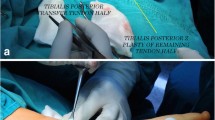Abstract
We describe a new anchoring method for tarsal tendon transfers in myelomeningocele patients to protect the sole of the foot from pressure sores and skin necrosis and to loosen the tension of the transferred tendon.
Tendon transfer procedures were performed in 51 feet (33 patients) with myelomeningocele. We transferred tibialis anterior tendons to the second or third cuneiform in 19 with equinovarus deformities, and transferred tibialis anterior tendons to the calcaneus through the interosseous membrane in 32 with talipes calcaneus. Clinical results were evaluated with the muscle power of transferred tendons using manual muscle testing 6 months after surgery. The muscle test result was classified as good, fair, and poor.
After passing the tendon through the bony hole, a 2.0-mm Kirschner wire was inserted from the sole to the tibia through the ankle joint at neutral. (It extended from the sole through the posterior cortex of the tibia.) The remaining part of the wire was bent and formed into a loop shaped like the Greek letter “zeta” (ζ). The thread was then tied to the loop of the wire as tightly as possible. In this way, there was no contact with the sole during anchoring, thus avoiding ulcers. In addition, the transferred tendon could be kept stable because the patient’s ankle was fixed by the Kirschner wire.
No cases of wound infection or skin necrosis of the sole occurred. In 49 of the 51 cases, transferred tendons were firmly anchored to tarsal bones. Muscle strength was good for 83%, fair for 13%, and poor for 4%. Consequently, 45 feet could obtain plantigrade pattern during their walking with shoe inserts or occasional use of ankle-foot orthoses.
Our anchoring method has the advantage of protecting the sole of the foot from pressure sores and skin necrosis, as well as maintaining tension on the transferred tendon until it settles down in an anchor hole.


Similar content being viewed by others
References
Bliss DG, Menelaus MB (1986) The results of transfer of the tibialis anterior to the heel in patients who have a myelomeningocele. J Bone Joint Surg Am 68:1258–1264
Cheng YM, Chien SH, Chou PH, Lin SY (1994) A flexional method of tendon transfer in foot surgery. Gaoxiong Yi Xue Ke Xue Za Zhi 10:97–99
Ezra E, Hayek S, Gilai AN, Khermosh, Wientroub S (2000) Tibialis anterior tendon transfer for residual dynamic supination deformity in treated club foot. J Pediatr Orthop Br 9:207–211
Georgiadis GM, Aronson DD (1990) Posterior transfer of the anterior tibial tendon in children who have a myelomeningocele. J Bone Joint Surg Am 72:392–398
Garceau GJ, Manning KR (1940) Transposition of the anterior tibial tendon in the recurrent club feet. J Bone Joint Surg Am 22:932–936
Herring JA (2001) Tachdjian’s pediatric orthopaedics, from the Texas Scottish Rite Hospital for Children, 3rd edn. W.B. Saunders Co., Philadelphia, p 1266
Peabody CW (1938) Tendon transposition an end-result study. J Bone Joint Surg Am 20:193–205
Ponseti IV, Smoley EN (1963) Congenital club foot: the results of treatment. J Bone Joint Surg Am 45:261–275
Author information
Authors and Affiliations
Corresponding author
Additional information
An erratum to this article can be found at http://dx.doi.org/10.1007/s11832-008-0110-4
About this article
Cite this article
Tomonori, K., Makoto, K. & Takashi, S. New anchoring method for tarsal tendon transfers in myelomeningocele patients. J Child Orthop 1, 369–371 (2007). https://doi.org/10.1007/s11832-007-0060-2
Received:
Accepted:
Published:
Issue Date:
DOI: https://doi.org/10.1007/s11832-007-0060-2




